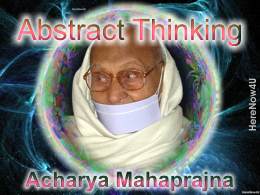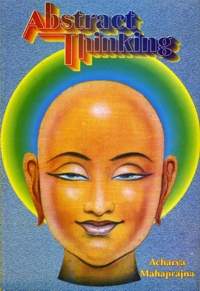
The first principle of wholesome thinking is - the anupreksha of otherness, of separation. What could not be accomplished before can be accomplished through this anupreksha. The bhavana of otherness is the basis of right vision.
"I am different from the body and the body is different from me" - this is the bhavana, the anupreksha of otherness.
As this bhavana grows stronger, the knowledge of the soul, the light of the soul, scatters abroad thousands of rays and the darkness of delusion is dissolved. With the awakening of the bhavana of otherness, many complexes are dissolved. All the tensions created by a person through the identification of himself with his body, all the knots thus formed, are resolved. A man is freed of tensions and complexes.
Illness comes to the body and a man begins to lament. A little pain or hardship caused to the body quite humbles a person. You might think it is because of suffering. No, that is not true. It is not because of suffering. It is because of the complexes formed, because of a man's conditioning. Our attachment to the body is so great that we cannot endure the least pain caused to the body. Because of this attachment, even a little suffering becomes intolerable. But the persons in whom the bhavana of otherness is awakened - not a million sufferings can efface their sweet smile. A look of misery never appears on their face. They are never depressed. Even great physical pain they quite ignore; they do not pay any attention to it. A man does not cry so much because of suffering caused to the body. What makes him lament is the belief that his body should not be subjected to suffering. With the strengthening of the bhavana of otherness, the complex that "his body should not be subjected to suffering", is dissolved, the knot is unravelled. If still there is pain, one observes it like a spectator. There is some movement in the body; something is happening there. The man is only a spectator, without any identification, or involvement.
A person came to me. He was practising meditation. I asked him, "How is your meditation going on?" He said: "I felt pain in the body, so I have just stopped meditating." I suggested, "Why not observe your pain? Why not concentrate your attention on the spot where there is pain?" He did that. The process of meditation continued for 5-10 days. As his meditation matured, all consciousness of pain disappeared.
To whom is the pain caused? To the soul or the body? The soul suffers no pain. We have identified all our consciousness with pain. And we have done it on the basis of the belief that it is I who am suffering this pain. If we learn to discriminate, if the idea of otherness becomes clear, we shall find ourselves ensconced in such a ventilator of health from where we would be able to observe pain like a spectator. We would be able to say to ourselves, "There is pain, there and here am I. There is the wayfarer, and here am I." Just as a man, looking through the window, sees another man walking on the road outside, similarly he will be able to observe pain as distinct from himself. Such a state comes into being with the development of the bhavana of otherness. I am not taking metaphysics. Had I been doing so, my view would have called forth an opposite view; my argument would then be confronted with a counter-argument, my dictum with a counter-dictum.
But what I am saying pertains to sadhana: Every person must experience it for himself. Each person's experience is his own. A sadhak should develop his power of discrimination, awaken his consciousness of discretion, practise the anupreksha of separation of the soul and the body from the background of the soul, and he should practise kayotsarga, (relaxation with self-awareness). Having reached this stage, he should find out whether he can look at pain as distinct from himself or not.
Whoever practised kayotsarga, practised it on the ground of sadhana. And whoever awakened his insight, did so on the ground of sadhana. It is only through sadhana that a person comes to experience for himself that the soul is different from the body and the body is different from the soul. A man cannot reach this stage through mere logic.
There are two things - one academic and the other pertaining to direct experiencing. The academic things are acquired from the agama, from a teacher, or from tradition. Many people have learnt the following aphorism by heart: "The soul is different, and matter is different." But when their body is troubled by suffering and pain, they clean forget this doctrine. In such situation, the doctrine fails. It is bound to fail. Because they have merely crammed the doctrine: for them it is merely academic. What is academic has its limits. To begin with, a thing may be accepted academically; it may be taken on trust, borrowed. But what is taken on loan must be returned. One has to acquire something for oneself. We must directly experience the truth of what we have learnt. We must feel in ourselves that the soul is different from the body and the body is different from the soul. Only then real things will start happening. As one delves deep into the truth of life, one finds that even creation is accidental, ephemeral. It is like an inn where travellers come from various directions, rest for a while and return to their respective places. What kind of identification is possible with the wayfarers? How long can association with them last?
In all comings-together and separations, to live without identifying oneself with anything, is the objective behind the bhavana of otherness.
 Acharya Mahaprajna
Acharya Mahaprajna

